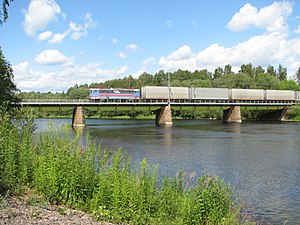Kil-Ställdalen railway line
| Kil – Ställdalen | |||||||||||||||||||||||||||||||||||||||||||||||||||||||||||||||||||||||||||||||||||||||||||||||||||||||||||||||||||||||||||||||||||||||||||||||||||||||||||||||||||||||||||||||||||||||||||||||||||||||||||||||||||||||||||||||||||||||||||||||||
|---|---|---|---|---|---|---|---|---|---|---|---|---|---|---|---|---|---|---|---|---|---|---|---|---|---|---|---|---|---|---|---|---|---|---|---|---|---|---|---|---|---|---|---|---|---|---|---|---|---|---|---|---|---|---|---|---|---|---|---|---|---|---|---|---|---|---|---|---|---|---|---|---|---|---|---|---|---|---|---|---|---|---|---|---|---|---|---|---|---|---|---|---|---|---|---|---|---|---|---|---|---|---|---|---|---|---|---|---|---|---|---|---|---|---|---|---|---|---|---|---|---|---|---|---|---|---|---|---|---|---|---|---|---|---|---|---|---|---|---|---|---|---|---|---|---|---|---|---|---|---|---|---|---|---|---|---|---|---|---|---|---|---|---|---|---|---|---|---|---|---|---|---|---|---|---|---|---|---|---|---|---|---|---|---|---|---|---|---|---|---|---|---|---|---|---|---|---|---|---|---|---|---|---|---|---|---|---|---|---|---|---|---|---|---|---|---|---|---|---|---|---|---|---|---|---|---|---|---|---|---|---|---|---|---|---|---|---|---|---|---|---|
|
A train crosses the Klarälv near Deje
| |||||||||||||||||||||||||||||||||||||||||||||||||||||||||||||||||||||||||||||||||||||||||||||||||||||||||||||||||||||||||||||||||||||||||||||||||||||||||||||||||||||||||||||||||||||||||||||||||||||||||||||||||||||||||||||||||||||||||||||||||
| Route number : | 10 | ||||||||||||||||||||||||||||||||||||||||||||||||||||||||||||||||||||||||||||||||||||||||||||||||||||||||||||||||||||||||||||||||||||||||||||||||||||||||||||||||||||||||||||||||||||||||||||||||||||||||||||||||||||||||||||||||||||||||||||||||
| Course book range : | 75 | ||||||||||||||||||||||||||||||||||||||||||||||||||||||||||||||||||||||||||||||||||||||||||||||||||||||||||||||||||||||||||||||||||||||||||||||||||||||||||||||||||||||||||||||||||||||||||||||||||||||||||||||||||||||||||||||||||||||||||||||||
| Route length: | 141 km | ||||||||||||||||||||||||||||||||||||||||||||||||||||||||||||||||||||||||||||||||||||||||||||||||||||||||||||||||||||||||||||||||||||||||||||||||||||||||||||||||||||||||||||||||||||||||||||||||||||||||||||||||||||||||||||||||||||||||||||||||
| Gauge : | 1435 mm ( standard gauge ) | ||||||||||||||||||||||||||||||||||||||||||||||||||||||||||||||||||||||||||||||||||||||||||||||||||||||||||||||||||||||||||||||||||||||||||||||||||||||||||||||||||||||||||||||||||||||||||||||||||||||||||||||||||||||||||||||||||||||||||||||||
| Power system : | 15 kV 16 2 / 3 Hz ~ | ||||||||||||||||||||||||||||||||||||||||||||||||||||||||||||||||||||||||||||||||||||||||||||||||||||||||||||||||||||||||||||||||||||||||||||||||||||||||||||||||||||||||||||||||||||||||||||||||||||||||||||||||||||||||||||||||||||||||||||||||
| Top speed: | Bandel 327: (Ställdalen) - (Hällefors): 140 km / h Bandel 326: Hällefors– (Kil): 140 km / h |
||||||||||||||||||||||||||||||||||||||||||||||||||||||||||||||||||||||||||||||||||||||||||||||||||||||||||||||||||||||||||||||||||||||||||||||||||||||||||||||||||||||||||||||||||||||||||||||||||||||||||||||||||||||||||||||||||||||||||||||||
|
|||||||||||||||||||||||||||||||||||||||||||||||||||||||||||||||||||||||||||||||||||||||||||||||||||||||||||||||||||||||||||||||||||||||||||||||||||||||||||||||||||||||||||||||||||||||||||||||||||||||||||||||||||||||||||||||||||||||||||||||||
|
Explanation: |
|||||||||||||||||||||||||||||||||||||||||||||||||||||||||||||||||||||||||||||||||||||||||||||||||||||||||||||||||||||||||||||||||||||||||||||||||||||||||||||||||||||||||||||||||||||||||||||||||||||||||||||||||||||||||||||||||||||||||||||||||
The Kil-Ställdalen railway is a standard-gauge Swedish railway line . It is part of the historical and also the so-called Bergslagsbanan today .
history
The railway line from Kil to Ställdalen is the middle section of the main line of the former Järnvägar (BJ) mountain camps . The entire route led from Gothenburg to Falun . Traffic on the Kil – Ställdalen section began in 1877, and the entire line was put into operation two years later.
The line was electrified during the Second World War . In this catenary of concrete used because they were cheaper at the time than steel masts. Recently, however, the concrete masts have been replaced by steel masts.
Statens Järnvägar took over the BJ's traffic in 1948. In 1970, continuous passenger traffic on the line was discontinued, but 15 years later local traffic with type X16 electric rail buses between Kil and Ställdalen was resumed. Since then, passenger transport has changed again and again, in the 1990s it was restricted to such an extent that only one pair of trains ran in the summer. In 1992 a direct train ran between Kristinehamn and Östersund via Ställdalen.
The connection to the southernmost part of the inland railway has changed over the years. The BJ and Östra Wermlands Järnväg (ÖWJ) ( Kristinehamn – Filipstad railway line ) used to meet in Herrhult. In 1964, the connection from Nykroppa on the former ÖWJ to Bergslagsbanan was moved to the west and the old connection between Nykroppa and Herrhult was dismantled. In 2002 a new connecting track was built in the direction of Ställdalen, so that there is now a track triangle at Nykroppa.
This connection enabled new connections in passenger traffic from Kristinehamn to Ludvika via Nykroppa, Hällefors and Ställdalen. The trains consisted of type Y1 diesel multiple units , which were jointly operated by Värmlandstrafik , Rikstritten and Tågkompaniet . In 2010 Rikstrafik decided not to subsidize these trains any further. They were discontinued when the timetable changed in June 2011.
Regular passenger traffic is carried out by Tågåkeriet i Bergslagen (Tågab), with only two to three trains stopping in Ställdalen on certain days of the week.
Freight transport
The freight on the track is relatively small. There are only a few through freight trains, such as a timber train from Borlänge to the paper mill in Grums or an oil train from Gothenburg to Borlänge. These trains are transported by Green Cargo with locomotives of the Rc2 and Rc4 series .
Green Cargo also transports steel between Hällefors and Hofors, usually using locomotives of the Ma series. On the section Nykroppa-Hällefors wrong pair of trains between a daily Kristinehamn and Hällefors, conveyed by Tågab with diesel engines of the type TMY . These trains use the new Gleisdreieck and thus have a much shorter journey time. Tågab also runs from Filipstad to Kristinehamn between Daglösschen and Nykroppa .
Kilnedre – Fryksta railway line
In 1871, instead of the first narrow-gauge Swedish railway line Fryksta – Lyckan, which was closed in the same year , a new rail connection to the Fryken was built. The starting point was the old SJ station in Kil. The three-kilometer route was opened on June 15, 1872.
However, when the Kil – Molkom section of the Bergslagsbanan was built in 1876 , the BJ did not want to use the same station. Therefore the new Kil railway station was built about 1.5 km to the west. The old SJ station was renamed Kilneedre . From 1906 the new Kil station was also used for the branch line to Fryksta and the old line to Kilnedre was dismantled.
The line was electrified on June 15, 1937. Passenger traffic took place only during the summer months, when there was a connection to the ships in Fryksta. This seasonal traffic, like the freight traffic, was stopped at the end of 1958. In 1973 the track was sold to the city of Kil. In 1974 the line was dismantled.
Individual evidence
- ↑ JNB 2020 Bilaga 3 E STH per sträcka. (PDF) Utgåva 2019-06-26. trafikverket.se, June 26, 2019, p. 147 , accessed on August 21, 2019 (Swedish).
- ↑ Järnvägshistoriskt forum Bangårdsskisser Herrhult. Retrieved July 1, 2014 (Swedish).
- ↑ to banvakt.se, bandel 390
- ^ Association of Central European Railway Administrations (ed.): Station directory of the European railways . (formerly Dr. KOCH's station directory). 52nd edition. Barthol & Co., Berlin-Wilmersdorf 1939.
- ↑ Kil – Daglös – Ställdalen. Bergslagsbanan. In: jarnvag.net. Retrieved August 21, 2019 (Swedish).
- ↑ 75 - Falun - Hällefors - Kristinehamn - Gothenburg. In: tagtidtabeller.resrobot.se. August 19, 2019, accessed August 21, 2019 (Swedish).
- ↑ History of Nordvästra stambanan (swed.)
- ↑ Frykstad-Klarälvens Järnväg. In: Cykla Banvall. Retrieved February 5, 2016 (Swedish).
Web links
- Kil – Daglös – Ställdalen. Bergslagsbanan. In: jarnvag.net. Retrieved August 21, 2019 (Swedish).
- Bergslag canals. (PDF) 2009, archived from the original on August 12, 2010 ; Retrieved August 21, 2019 (Swedish, map).
